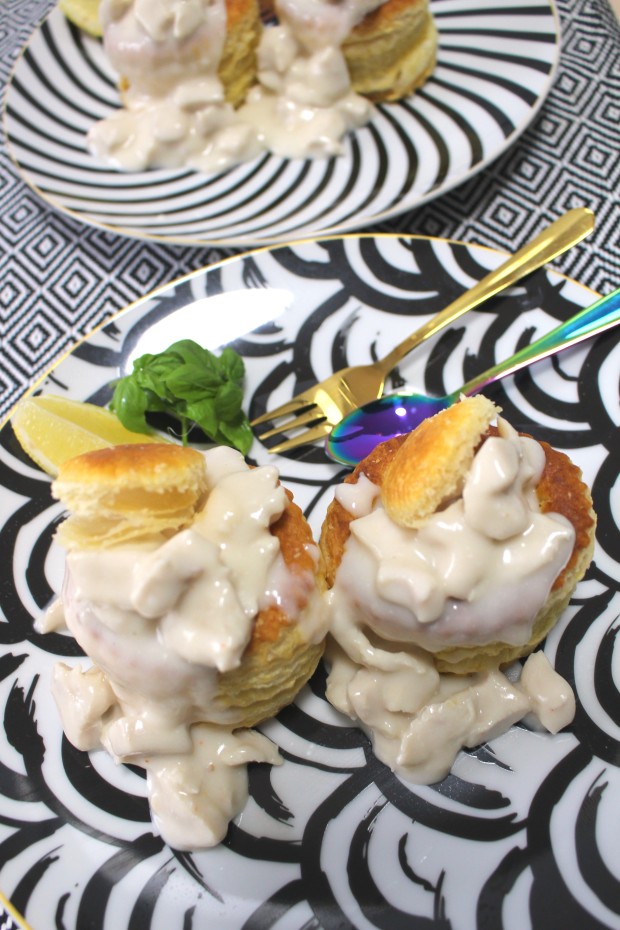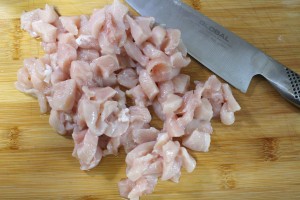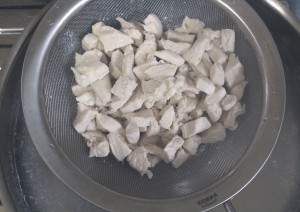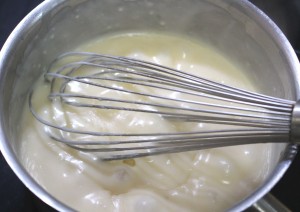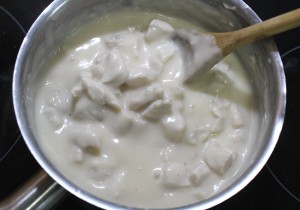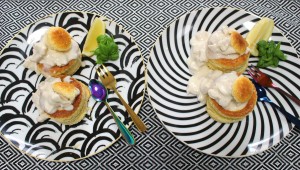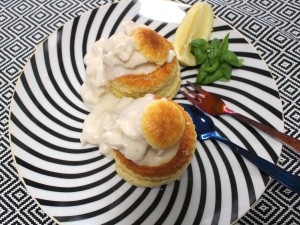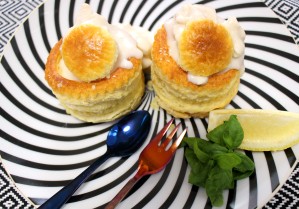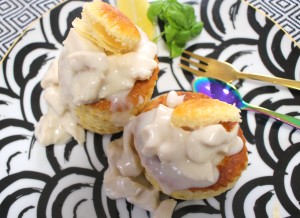:
:
When I was a kid and later as an apprentice and a young cook, this dish was available in most good restaurants as a standard a la carte Item, either as a light snack consisting of one vol au vent, or two vol au vents accompanied by a small salad as a main course, most popular with ladies and children. It often also was part of a menu of several dishes, as well as part of after-dinner small dish menus, which were served between the end of regular food serving time and closing time. Aahhh, the good old times. 🙂
Classic ragout fin consists of veal, sweetbread, calf brain, tongue and bone marrow, chicken breast, mushrooms and/or fish, bound with Sauce Allemande (Sauce Suprême).
Nowadays, unless we are in a VERY hi-class french cuisine restaurant, ragout fine usually means a fine ragout of diced veal or chicken and diced mushrooms, bound with Sauce Velouté, sometimes topped with a dollop of Sauce Hollandaise.
:
Bon Appétit ! Life is Good !
:
:
Following, find an excerpt from 196 Recipes :
” There is often some confusion between a bouchée à la reine and a vol-au-vent. The first one is attributed to a French queen, while the last one is the work of one of the greatest French chefs of the time. Indeed, it is to Marie Leczinska (1703-1768), Queen of France and wife of Louis XV, that we owe the delicious recipe for bouchée à la reine. Marie Leczinska was the daughter of King Stanislaus of Poland, who was dethroned and exiled to Lorraine, in the east of France.
BRIEF HISTORY OF MARIE LECZINSKA
When Louis XV, who was only fifteen years of age, fell ill again in 1725, the Duke of Bourbon feared for his future that the Duke of Orleans, his rival, would ascend the throne. To avoid this, it was necessary that Louis XV assured a descent as soon as possible. After drawing up a list of one hundred European princesses to marry, Marie Leszczynska, seven years older than him, was chosen, as she was old enough to have children.
This very discreet and very pious woman was a devoted mother and wife. Her marriage to Louis XV in 1725 was nevertheless welcomed as a disappointment by the people as the union was not deemed prestigious enough for a king of France. Nevertheless, helped by her sweetness and her beneficent character, she finally won the hearts of the people. The marriage will be happy, at least during the first years. The young king of France was sincerely in love with his wife, and Marie gave him no less than ten children in ten years. However, her successive maternities tired her and made her age early. Louis XV began to leave her for his mistresses, the best known of which were Madame de Pompadour and Madame du Barry.
WHAT IS THE ORIGIN OF BOUCHÉE À LA REINE?
Inspired by pastries made from sweet puff pastry like the puits d’amour (wells of love) created by chef Vincent La Chapelle, at the request of her rival Madame de Pompadour, Marie then ordered the kitchens of the Court, and in particular Nicolas Stohrer, creator of the baba au rhum (rum baba), a dish that would attempt to awaken the ardor of her unfaithful husband. Thus she had the idea of bouchée à la reine. The goal was to use ingredients with supposedly aphrodisiac properties. The original recipe mentioned puff pastries garnished with a salpicon (a mixture of vegetables, fish or meat). The original garnish of these bouchées à la reine mentions sweetbreads, lamb’s brains, cock’s crests and kidneys, marrow, quenelles of poultry, lamb testicles, truffles and mushrooms, green olives, all bound by a sauce financière. This recipe did not really have the effect expected by the queen, since King Louis XV accumulated infidelities until the end of his life. On the other hand, the bouchée à la reine became a huge success. Indeed, Stanislas, father of the queen and Duke of Lorraine, contributed to its popularity in the buffets of the nobility of Lorraine. The bouchée à la reine is today a must in the French gastronomy, just like the quiche lorraine. Nowadays, the bouchée à la reine comes in many forms, the most classic recipes being based on chicken, quenelle, sweetbreads or seafood. The sauce, often garnished with chopped button mushrooms (champignons de Paris), must be thick enough so that the puff pastry remains crisp. The queen and wife of Louis XV is also at the origin of other famous dishes like the consommé à la reine, the fillet of sirloin braised à la royale and was at the origin of the appearance of the lenses in the French cuisine.
WHAT IS THE ORIGIN OF VOL-AU-VENT?
Vol-au-vent (French for “windblown” to describe its lightness), meanwhile, is attributed to Antonin Carême, cook and author of culinary books. He replaced the crust of the bouchée à la reine which was a dough similar to a shortcrust pastry, by a lighter puff pastry. Carême popularized the use of a lighter and crisp puff pastry to make pies, whether savory or sweet. Vol-au-vent therefore refers to the puff pastry container. The vol-au-vent fillings are varied, usually based on meat, sweetbreads, fish, shellfish, snails, or mushrooms. The mixture is bound with a thick sauce like a bisque, bechamel sauce, with cream, with Nantua, sauce suprême or sauce financière. Originally, the size of the vol-au-vent is about 6 to 8 inches. It is only from the middle of the 20th century that the size of the vol-au-vent merges with that of bouchée à la reine, which is closer to 4 inches in diameter. The hors d’oeuvre called mini bouchée or bouchée mignonne, meanwhile, is usually 2 inches in diameter.
THE BOUCHÉE À LA REINE, POPULARIZED BY ESCOFFIER
In 1902, chef Auguste Escoffier listed sixteen recipes of appetizers of different appellations, shapes and garnishes, including the bouchée à la reine. Among its different recipes, you can find :
– Bouchée Bouquetière, made from a vegetable brunoise
– Bouchée Diane, game-based
– Bouchée Grand Duc, made with asparagus tips and truffles
– Bouchée Montglas, made with foie gras and mushrooms
– Bouchée Nantua, made from crayfish tails and Nantua sauce
– Bouchée Victoria, made with lobster meat and lobster sauce
The lid of the bouchées can be puff pastry, truffle or borrowed from the main element of the filling.
HOW TO SERVE A BOUCHÉE À LA REINE
The bouchée à la reine is usually served as a starter, presented by itself on a plate or accompanied by a green salad. When served as a main dish, it can be served with rice, mashed potatoes or pasta, as in Lorraine, where it is often accompanied by noodles or spätzle. Some add a good ladle of the filling on the side. Most people buy pre-made vol-au-vent, and I would do the same if I lived in France. Only, outside of France, these small puff pastry containers are difficult to find. Never mind, if you manage to find puff pastry or even better, if you have the courage to make homemade puff pastry, you can very easily make them yourself and fill them to make bouchée à la reine, whether classic or not. Just use your imagination! “
:
:
:
:
:
:
:
:
:
:
:
Preparation :
To read instructions, hover over pictures
To enlarge pictures and read instructions, click on pictures
:
:
Click here for Sauce Velouté Recipe
:
:
- remove skin from 2 ea chicken breasts (Reserve skins for another dish)
- dice the chicken
- simmer in salted water for 2 minutes
- drain, rinse /reserve the stock for the “Sauce Suprême”
- sauce suprême is made with a ‘Sauce Veloutée’ , which is enriched with egg-yolks and heavy cream (Liaison), and finished with a dash of lemon juice. It is used with veal, and chicken dishes.
- add the chicken to the sauce supreme, mix, check/adjust the flavor, divide the ragout between 4 ea vol au vent
- “BOUCHÉE À LA REINE RAGOUT FIN” (VOL-AU-VENT) (KÖNIGIN PASTETE)
- “BOUCHÉE À LA REINE RAGOUT FIN” (VOL-AU-VENT) (KÖNIGIN PASTETE)
- “BOUCHÉE À LA REINE RAGOUT FIN” (VOL-AU-VENT) (KÖNIGIN PASTETE)
- “BOUCHÉE À LA REINE RAGOUT FIN” (VOL-AU-VENT) (KÖNIGIN PASTETE)
- “BOUCHÉE À LA REINE RAGOUT FIN” (VOL-AU-VENT) (KÖNIGIN PASTETE)
- “BOUCHÉE À LA REINE RAGOUT FIN” (VOL-AU-VENT) (KÖNIGIN PASTETE)
- “BOUCHÉE À LA REINE RAGOUT FIN” (VOL-AU-VENT) (KÖNIGIN PASTETE)
:
:
:
:






